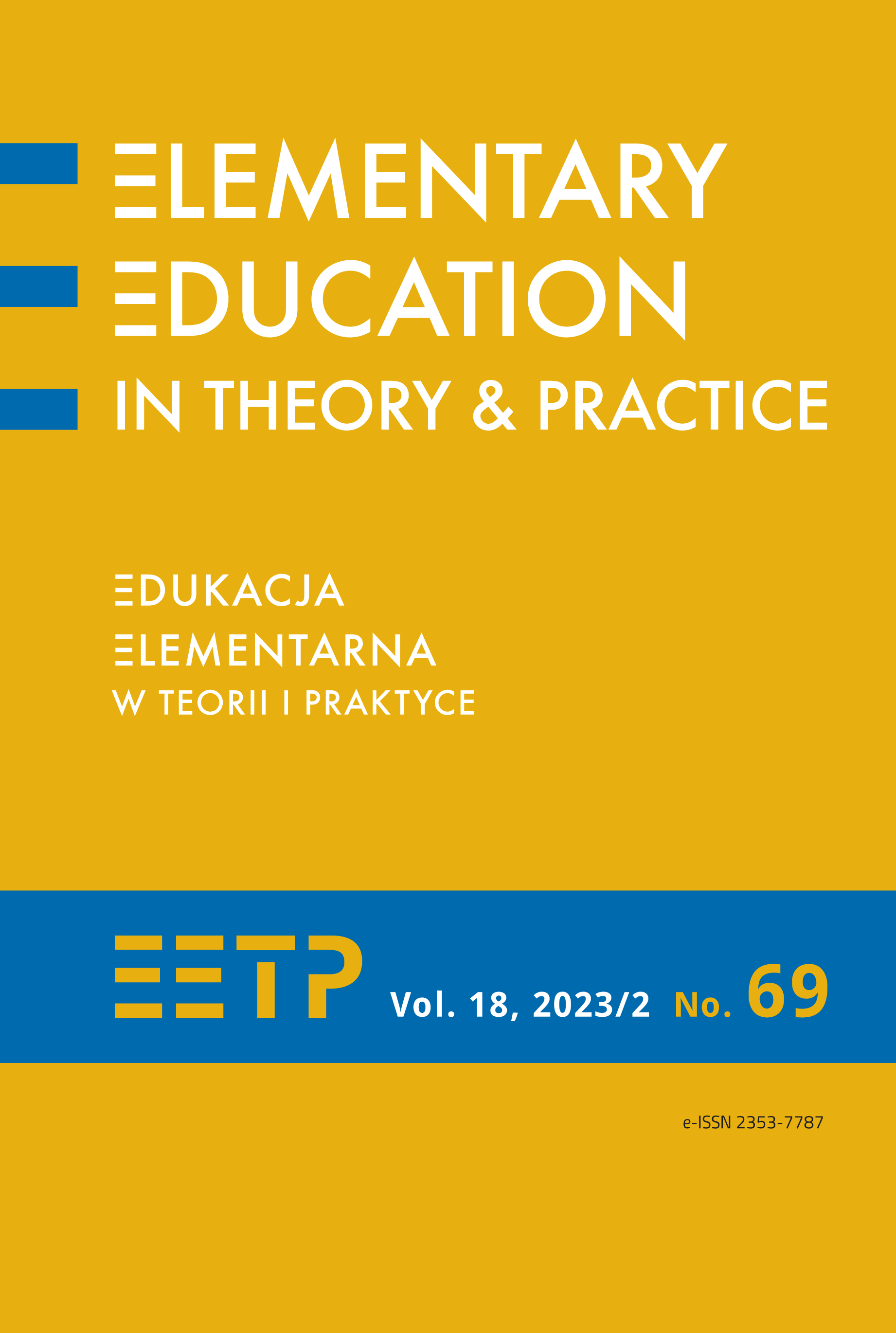From a Carpet Hanger to TikTok - on the Trail of New Childhood Spaces. Focus Research Report
Abstract
The article presents a report from the research conducted to reveal the specific aspects of children’s experiences related to functioning in the TikTok web application. The specific features and growing popularity of TikTok among children is as surprising for many adults as the phenomenon of carpet hangers (the symbol of pre-digital childhood in Poland) for the modern generation of children. The research was prepared within a qualitative strategy. Children aged 8–10 took part in focus group interviews. The thematic analysis showed that children have turned TikTok into a new informal e-playground. They participate in the TikTok community and create it. Children’s activity in this place fulfills the need to be with others, to create something together, but also the need for quick interaction, fun and entertainment. Children try to develop their interests and draw some inspirations to create their own “trends”. They do not live in a vacuum, but, as in offline life, they absorb what they watch and participate in. Functioning in the application is also a kind of resistance, as it is against the will of representatives of the adult world. However, discovering forbidden places or even undertaking risky social practices seems to be one of the distinctive features of childhood, regardless of the times in which it is fulfilled.
References
Braun, V. i Clarke, V. (2006). Using thematic analysis in psychology. Qualitative Research in Psychology, 3(2), s. 77–101. http://dx.doi.org/10.1191/1478088706qp063oa
Braun, V. i Clarke, V. (2022). Thematic analisis. A practical guide. SAGE.
Ciechowska, M. (2017). Badania fokusowe. W: M. Ciechowska i M. Szymańska (red.), Wybrane metody jakościowe w badaniach pedagogicznych. Cz. 1 (s. 101–163). Akademia Ignatianum w Krakowie i Wydawnictwo WAM.
Corsaro, W.A. (2015). The sociology of childhood. SAGE.
Dziekońska, J. (2020). Kultura dziecięca w internecie. Studium netnograficzne. Wydawnictwo Uniwersytetu Warmińsko-Mazurskiego w Olsztynie.
Janik, A. (2021). Podwórkowe przestrzenie i miejsca zabaw. Studium pedagogiczno-kulturowe. Instytut Pedagogiki Uniwersytetu Wrocławskiego.
Kubinowski, D. (2011). Jakościowe badania pedagogiczne. Filozofia, metodyka, ewaluacja. Wydawnictwo Uniwersytetu Marii Curie-Skłodowskiej.
Kvale, S. (2011). Prowadzenie wywiadów (A. Dziuban, tłum.). Wydawnictwo Naukowe PWN.
Lenzer G. (2002). Children’s studies and the human rights of children: toward an unified approach. W: K. Alaimo, B. Klug (red.), Children as equals: Exploring the rights of the child (s. 207–225). University Press of America.
Postman, N. (2011). The disappearance of childhood. Knopf Doubleday Publishing Group.
Qvortrup, J., Corsaro, W.A. i Honig, M.-S. (2009). The Palgrave handbook of childhood studies. Palgrave Macmillan.
Rixon, A., Lomax, H. i O’Dell, L. (2019). Childhoods past and present: Anxiety and idyll in reminiscences of childhood outdoor play and contemporary parenting practices. Children's Geographies, 5(17), 618–629. https://doi.org/10.1080/14733285.2019.1605047
Schellewald, A. (2021). Communicative forms on TikTok: Perspectives from digital ethnography. International Journal of Communication, 15, 1437–1457. https://ijoc.org/index.php/ijoc/article/view/16414
Siwicki. M. (2021), Nowe podwórka współczesnego dzieciństwa. Wydawnictwo Akademii Pedagogiki Specjalnej im. Marii Grzegorzewskiej.
Spitzer, M. (2021). Epidemia smartfonów. Czy jest zagrożeniem dla zdrowia, edukacji i społeczeństwa? (M. Guzowska, tłum.). Wydawnictwo Dobra Literatura.
Szymborska, K. (2016). Children studies jako perspektywa metodologiczna. Współczesne tendencje w badaniach nad dzieckiem. Teksty Drugie, 1, 189–205. https://doi.org/10.18318/td.2016.1.12
Zwiernik, J. (2009). Dziecięca codzienność w przestrzeni podwórka. W: D. Klus-Stańska i M. Szczepska-Pustkowska (red.), Pedagogika wczesnoszkolna – dyskursy, problemy, rozwiązania (s. 401–420). Wydawnictwa Akademickie i Profesjonalne.
Zwiernik, J. (2015). Przestrzenie i miejsca w krajobrazie dzieciństwa. W: T. Sadoń-Osowiecka (red.), Miejsce, przestrzeń, krajobraz: edukacyjne znaki (s. 13–38). Wydawnictwo Uniwersytetu Gdańskiego.
Zwiernik, J. (2020). Plac zabaw jako miejsce dla dzieci vs. miejsce dzieci. Problemy Wczesnej Edukacji, 3(50), 32–42. https://doi.org/10.26881/pwe.2020.50.03
Copyright (c) 2023 Elementary Education in Theory and Practice

This work is licensed under a Creative Commons Attribution-NoDerivatives 4.0 International License.
- When submitting a text, the author declares that he/she is the Author of the article (hereinafter referred to as the “Work”) and:
- he/she owns the exclusive and unlimited copyright to the Work,
- is entitled to dispose of the copyright to the Work.
Declares that it does not infringe any third party copyrights or legal rights.
Declares that there is no conflict of interest.
2. At the same time, the Author grants the Ignatianum University in Cracowa royalty-free, non-exclusive and territorially unlimited licence to use the Work in the following fields of exploitation:
- recording the Work in a hard copy, as well as on a digital or magnetic medium;
- reproduction of the Work using any technique, without limitation of the number of editions or copies;
- distribution of the Work and its copies on any medium, including marketing, sale, lending, and rental;
- introduction of the Work into a computer memory;
- disseminating the Work in information networks, including in the Internet;
- public performance, exhibition, display, reproduction, broadcasting and re-broadcasting, as well as making the Work available to the public in such a way that everyone can have access to it at a time and place of their own choosing;
- within the scope of dependent rights to the Work, including in particular the right to make necessary changes to the Work resulting from editorial and methodical development, as well as to translate the Work into foreign languages;
The licence is granted from the moment of the transfer of the Work to the Ignatianum University in Cracow. The Ignatianum University in Cracow is entitled to grant further sub-licences to the Work within the scope of the right granted. The licence is time-limited and it is granted for a period of 15 years, starting from the date of its granting.
Authors are permitted and encouraged to publish their text online (e.g. in their institution’s repository or on the institution’s website) before or during the submission process as this may lead to beneficial exchanges, as well as earlier and greater citation of the published text (See The Effect of Open Access). We recommend using any of the following portals of research associations:
- ResearchGate
- SSRN
- Academia.edu
- Selected Works
- Academic Search




